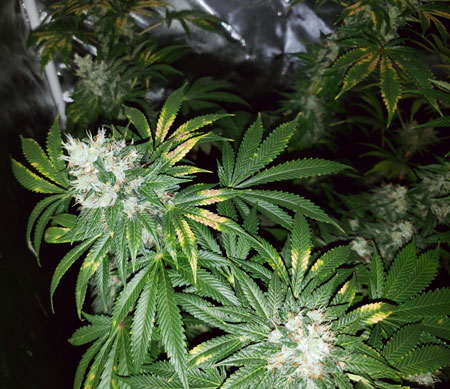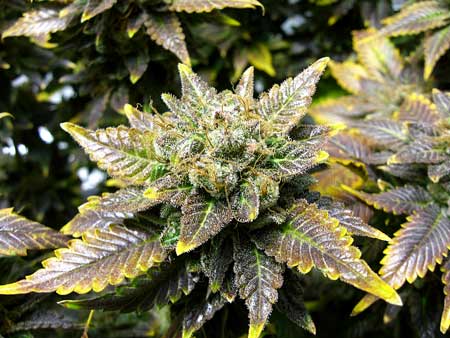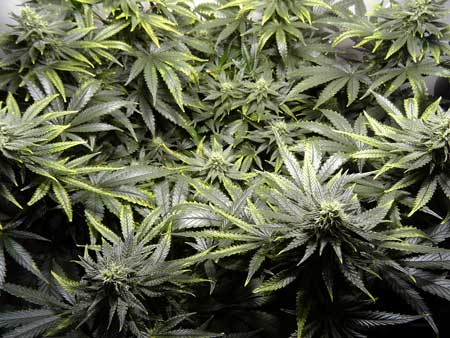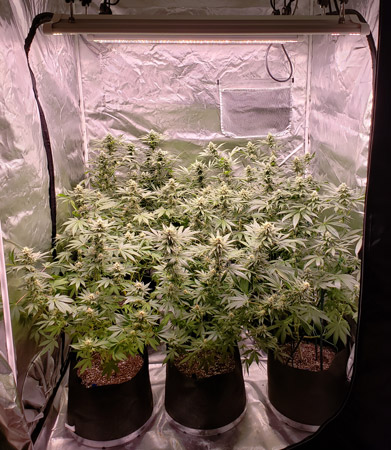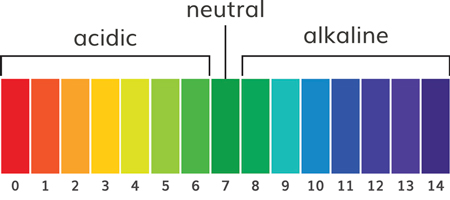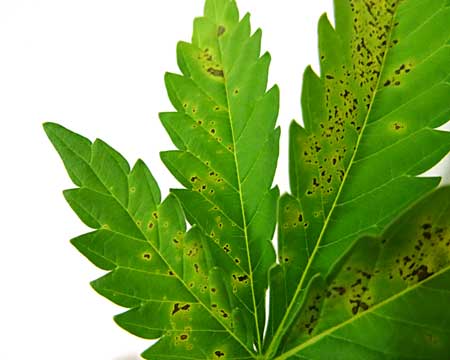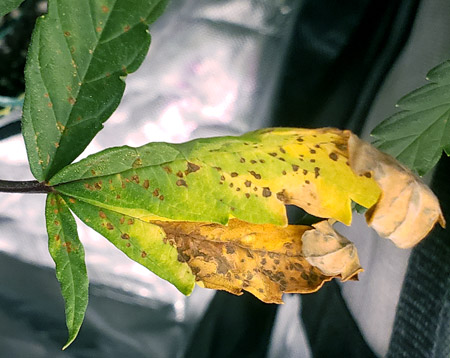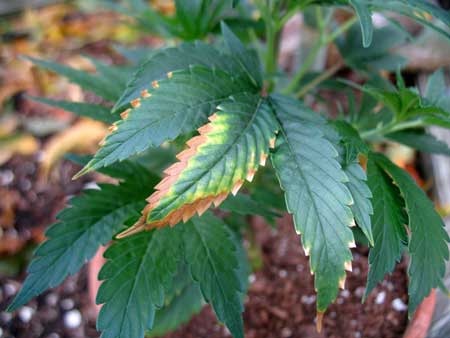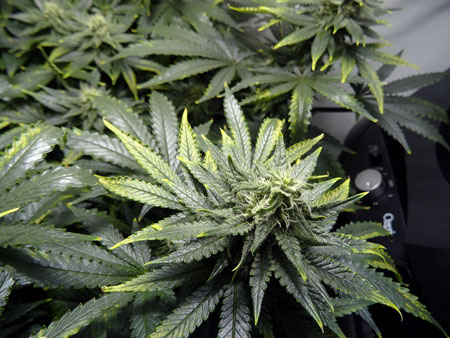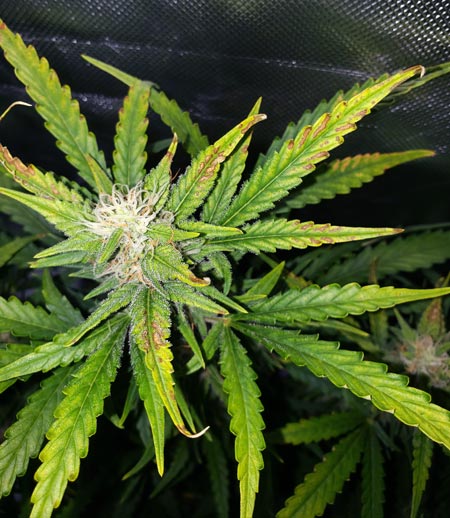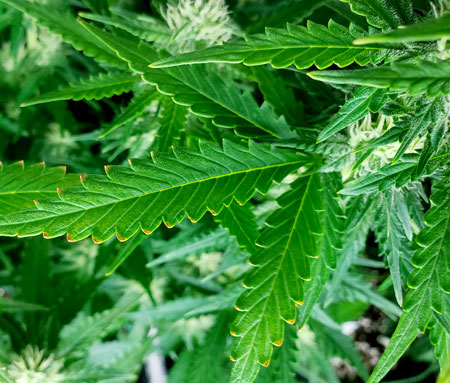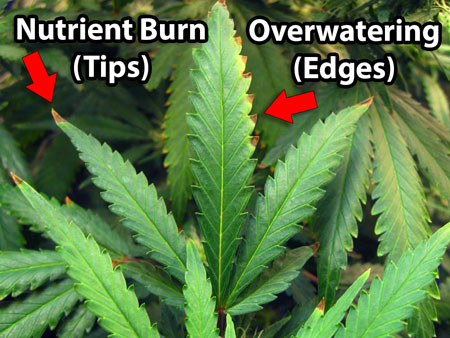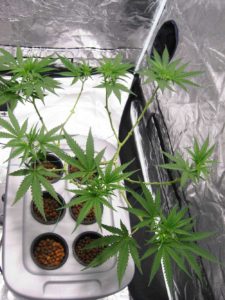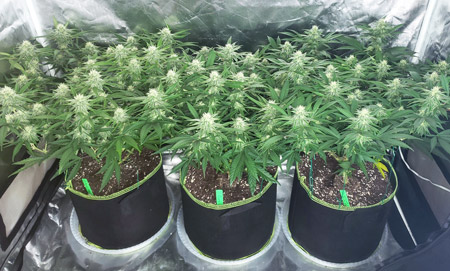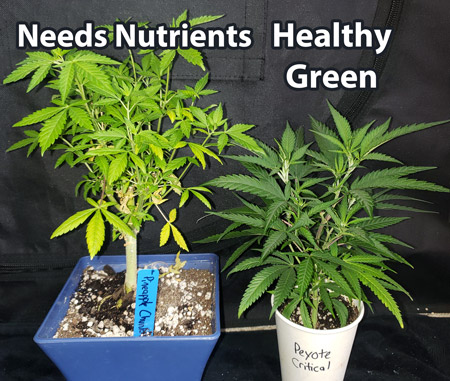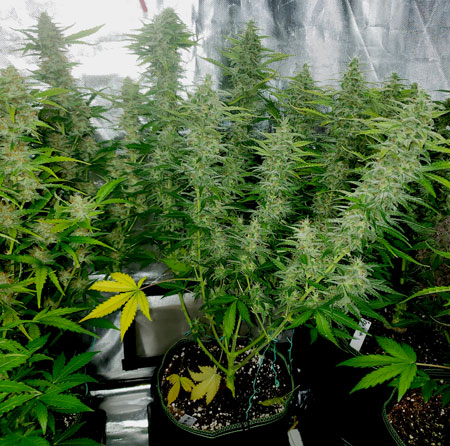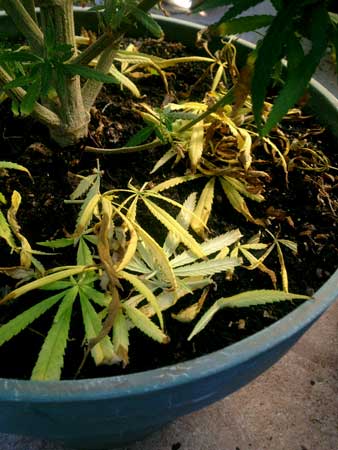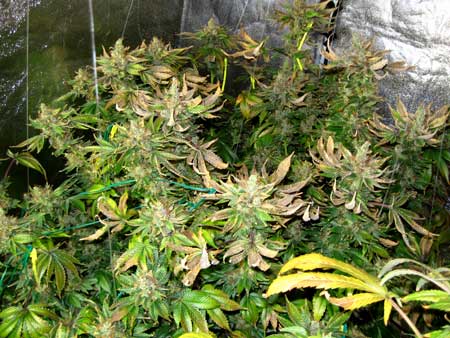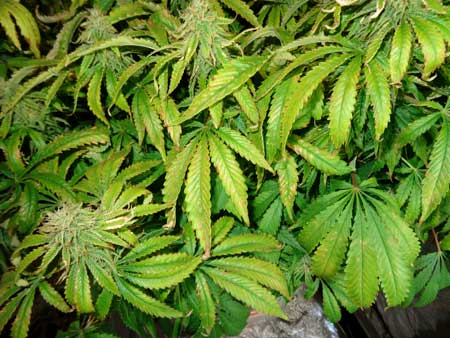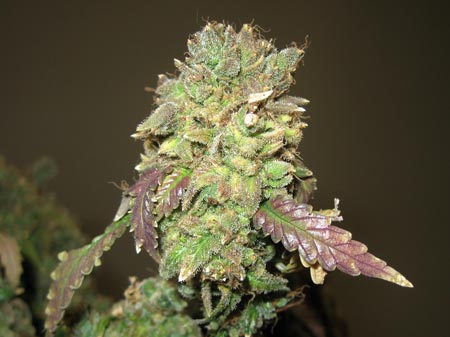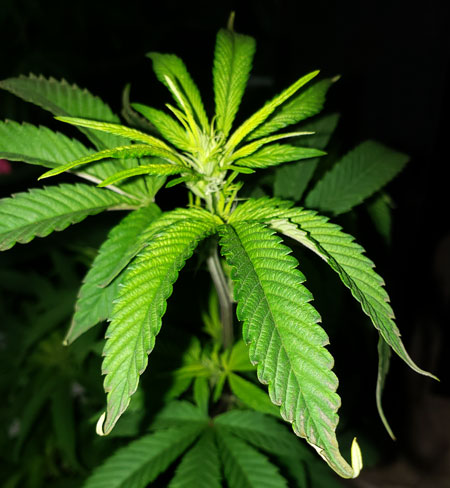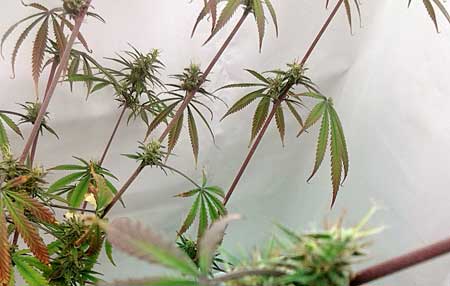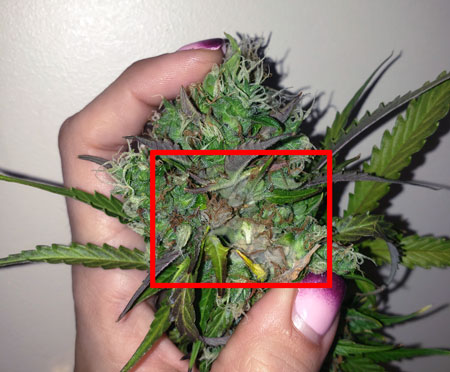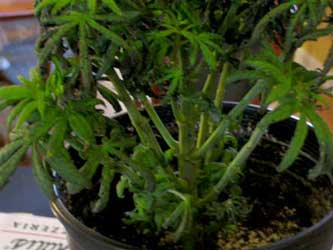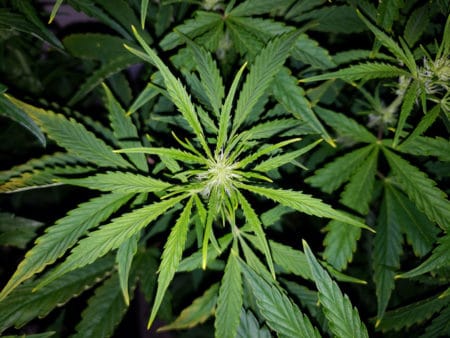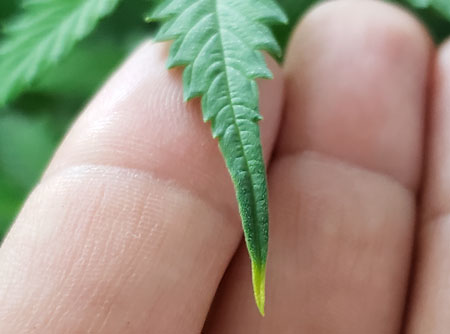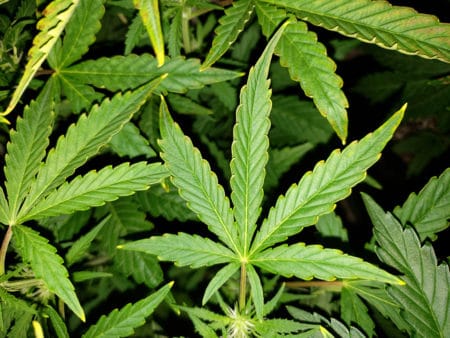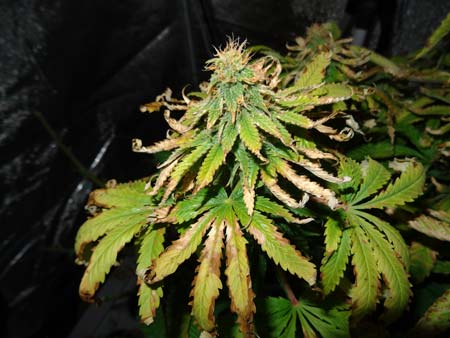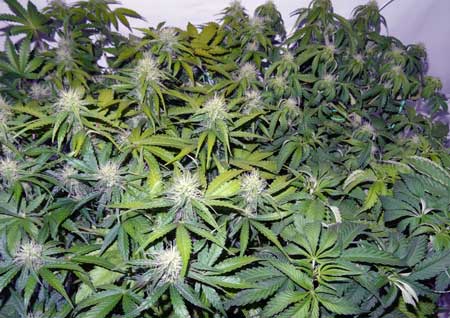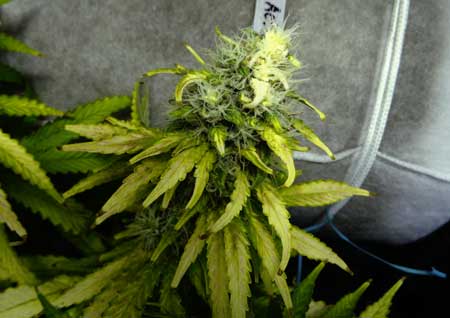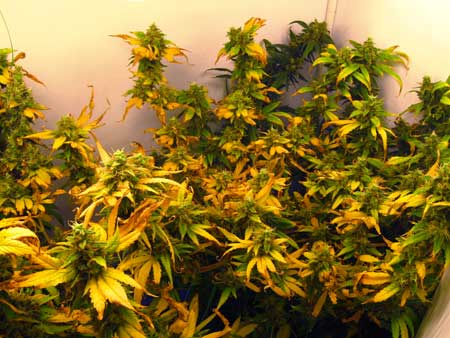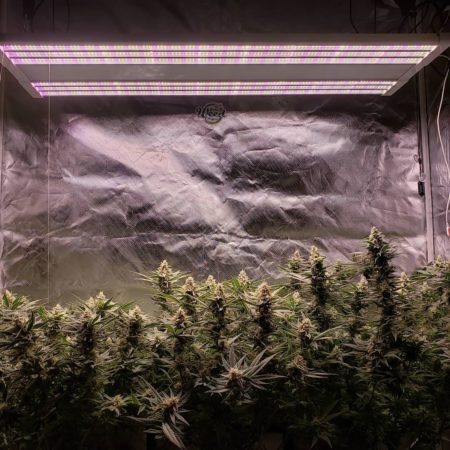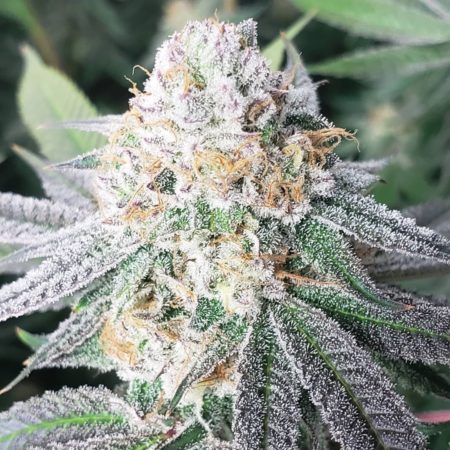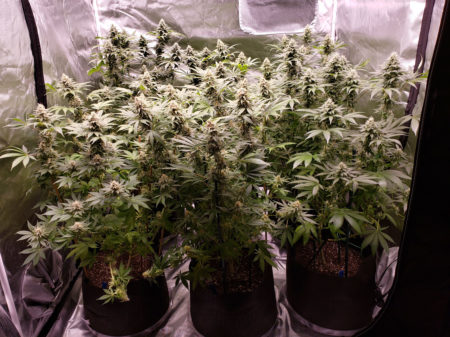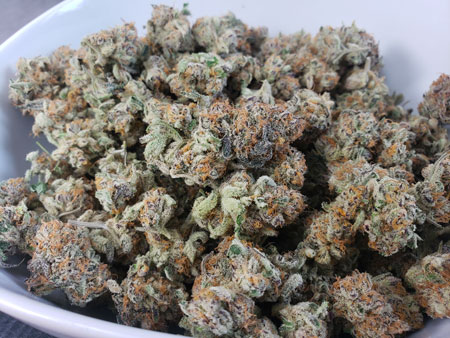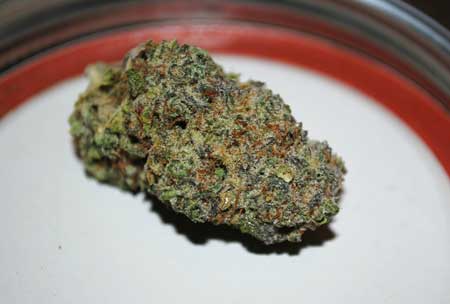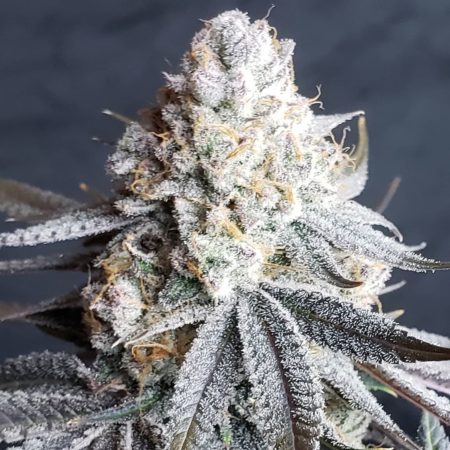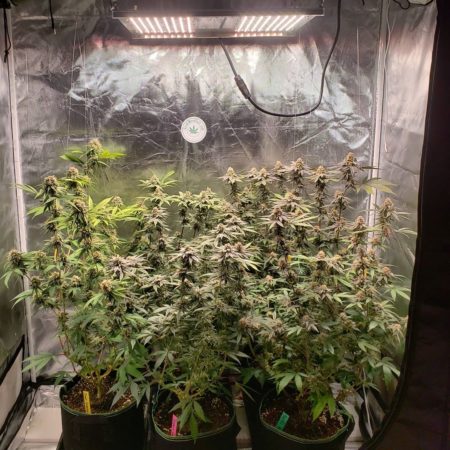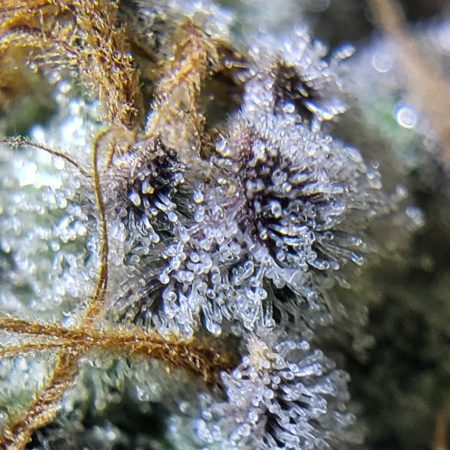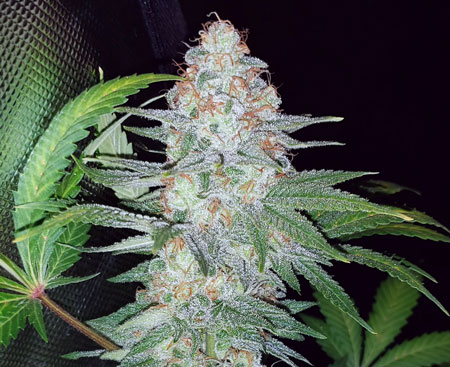by Nebula Haze
Your cannabis plants are growing buds! But wait… what’s that?
Yellow leaves, brown spots, and other random deficiencies are common flowering stage problems
This happened to me as a beginner cannabis grower. Every time I initiated the flowering stage, my once-healthy green plants would start getting nutrient deficiencies. What is the cause of this frustrating problem?
Why do so many cannabis plants get nutrient deficiencies in the flowering stage?
Why the flowering stage? Cannabis plants are tougher in the vegetative stage. With new leaves growing every day, no individual leaf ever has to work too hard. The plant is focused on growth and nothing else. Vegetative plants really “grow like a weed”. Yet as the flowering stage goes on, plants stop making new leaves and start focusing on buds. Each leaf works long, hard hours, and plants stop replacing them. Sick or discolored leaves remain until harvest, and if you don’t fix the issue, those leaves die the problem spreads to new parts of the plant. What could be a small problem in the vegetative stage can slowly take over your whole plant in the flowering stage.
Unfortunately, cannabis plants are more sensitive when they’re making buds. But never fear! This article explains exactly what’s causing your problem and how to fix it.
Note: All 3 of these pictures were caused by too high or too low pH at the roots. Incorrect pH is the most common reason for flowering stage deficiencies, which is why it’s first on the list below. However, there are many other factors that cause or contribute to flowering stage leaf problems such as a poor environment or incorrect plant care.
Today I’ll explain the most common reasons for flowering stage deficiencies with pictures, so you can fix your problems and once again start smiling every time you see your garden.
1.) Plant Care
Plant care refers to the daily care you give your plants. Let’s cover the most common plant care issues.
Give proper care in the flowering stage to keep cannabis plants healthy and happy
Incorrect PH
Incorrect pH at the roots is the most common reason growers see nutrient deficiencies. The pH affects how well the roots absorb nutrients because each nutrient takes a different chemical form depending on the pH, and some forms are easier for the roots to absorb than others. Plants often get pickier about pH in the flowering stage. Even if the plants seemed fine without pH adjustment in the vegetative stage, your first step if you see flowering stage nutrient deficiencies is to test the pH.
The wrong pH at the roots will cause nutrient deficiencies even if the nutrients are “there”
- Low pH is the most common pH problem for cannabis growers. Although cannabis plants like slightly acidic root conditions (5.5-6.5 pH in coco/hydro and 6-7 pH in soil), too low pH causes problems. Since neutral water has about 7 pH and tap water often has even higher pH (due to how the water was treated), many growers add PH Down (a strong acid) to adjust their water to a lower pH before watering plants. If the grower never gives enough water to get significant runoff out the bottom, the PH Down can start to build up over time and the root conditions have lower pH than the water going in. On top of that, many nutrients also reduce the pH, so a buildup of nutrients can cause the same issue.
- High pH can also happen. If PH Up needs to be added to the water it can also build up in the grow medium. Another issue is some growers never pH their water even if they have high pH. A plant that doesn’t “mind” in the vegetative stage can get more sensitive to pH in flowering. If you haven’t been checking pH, that’s the first thing to look at when you see nutrient deficiencies. High pH is also relatively common in hydroponic systems where the pH can swing upwards as the plant absorbs the acidic nutrients faster than it drinks the water.
The first 3 pictures on this page were caused by incorrect pH, but here are a few more examples of common flowering stage nutrients deficiencies with more information about how they’re affected by pH.
Calcium deficiencies are often caused by low pH and may first appear as brown spots or speckles
If the pH isn’t fixed, the spots from a calcium deficiency become brown patches that eventually destroy whole leaves. Yellow leaves from this deficiency usually don’t fall off on their own. Unlike some other deficiencies, the leaves are often stuck on (can’t easily be tugged off) even after the leaf looks completely dead.
Potassium deficiencies are relatively common in the flowering stage and often caused by high pH
Copper deficiencies are also caused by incorrect pH. The symptoms are dark (almost blue-looking) leaves with yellow edges.
How to Fix: Measure and adjust the pH of your water right before you give it to plants, even if you never needed to in the past.
- Add all nutrients and supplements to water
- Measure the pH of your water with strips, drops, or a pH pen
- Soil water should be between 6-7 pH
- Coco/Hydro water should be between 5.5-6.5 pH
- Adjust the pH to the proper level
- With most setups, use PH Up or PH Down
- If in an organic or living soil setup, use Earth Juice Natural Up or Natural Down (here’s an alternative Natural Down in case the Earth Juice version is sold out) to adjust pH without harming microbes in the soil.
- Test the pH of the runoff water
- If much higher than what you put in, lower the pH to the bottom of the range for the next few waterings
- If much lower, give water at the top of the pH range for the next few waterings
- Repeat
Always test the pH before giving water to plants!
If not adding any nutrients (for example with a “just add water” super soil grow), it’s recommended to avoid getting runoff water because it can wash away nutrients that need to be conserved in the soil until harvest. This can make it difficult to know what the pH is at the roots because there’s no way to measure the pH of the runoff.
If you’re using a high-quality neutral water source like bottled spring water (PPM between 40-100 and pH around 6.8-7 without any adjustment) then you probably don’t need to worry about pH and can go on to the next step to diagnose your issue. However, if you’re using tap water and adjusting the pH (even with Natural Up or Natural Down), then it’s possible the PH adjusters are building up in the soil since there’s no runoff. In this case, you have a couple of options. You could give a little more water than normal one time to get a tiny bit of runoff and test the pH. If the runoff pH is much higher or lower than the water going in, you’ve found your problem. Another (better) option is to switch to a higher-quality source of water that doesn’t need pH adjustment. It’s not uncommon for organic growers to start with tap water when plants are young and switch to bottled spring water before plants get more sensitive in the flowering stage. Giving plants a great source of water will naturally clear up anything built up in the soil over time.
Note: If your tap water isn’t great, bottled spring water is one of the best choices for “just add water” setups. You rarely have to worry about pH with spring water and it contains small amounts of minerals like calcium. Avoid using RO (reverse osmosis) or filtered water in a “just add water” setup because they don’t contain any minerals, which can actually make deficiencies more common.
Overwatering
Photoperiod plants often drink less immediately after the switch to 12/12. This happens because they’re suddenly getting less light a day. As the flowering stage goes on and plants get bigger, they’ll start drinking more again. However, it can be easy to overwater plants if you keep giving the same amount immediately after initiating the flowering stage. Many growers may not realize that overwatering (and in rare cases, underwatering) can actually cause the plant to get what appears to be nutrient deficiencies. The deficiencies happen because water isn’t moving properly in the plant, even if the pH is right and the nutrients are “there” in the grow medium.
Overwatering can cause symptoms that appear to be nutrient deficiencies. These brown scorch marks look a bit like a calcium deficiency but are actually the result of chronic overwatering.
Brown leaf edges can be a sign of overwatering
Sometimes brown leaf edges from overwatering can be confused for nutrient burn. Here’s a quick reference to help you know the difference.
How to Fix: Pay attention to the wetness of your grow medium after initiating 12/12. If it seems wetter than usual, try giving water less frequently or less at a time until plants are drinking normally again. Other signs of overwatering include droopiness and brown leaf edges. Learn how to water plants perfectly.
Too Much Defoliation
Defoliation is the process of removing leaves from the plant. When used strategically in the flowering stage, this technique can increase yields, density, and overall bud quality. However, after a few weeks of growing, many plants stop growing new leaves.
Beginners should never defoliate a plant until it looks bare in the flowering stage. This can cause stunting as well as nutrient issues down the road because the plant has less of a “buffer” against problems.
Avoid removing any leaves after plants have stopped getting bigger, especially if leaves seem pale and/or you’re not adding extra nutrients. For example, these plants shouldn’t be defoliated because they aren’t getting extra nutrients (they only have what’s there in the soil) and are well into the flowering stage. Each leaf stores nutrients for the plant to use later, and you don’t want to take away their nutrient stores.
How to Fix: Be careful not to take too many leaves in the flowering stage, especially after week 6. It’s recommended beginners never “strip” their plant, especially if dealing with any kind of problem or nutrient deficiencies. In general, be extra gentle with your plants the closer they are to harvest.
And for growers that don’t add extra nutrients, go lighter on defoliation (or even skip it altogether) to conserve nutrients in the leaves and soil to ensure plants don’t run out before harvest.
Nutrients Have Been Depleted
In some cases, you’re getting deficiencies because the nutrients have actually run out. Luckily, it’s easy to tell when plants need higher levels of nutrients overall. This is common for growers in a “just add water” setup, especially if you defoliated your plants or have been giving enough water to get runoff. Cannabis plants need relatively high levels of nutrients to produce buds and show specific signs when they’re running out.
Even if you are already adding nutrients via amendments or in the water, these symptoms indicate your plant wants more.
Signs this is your problem
- Pale/lime green leaves all over the plant, especially the leaves directly under the light and close to the biggest buds (these are the hardest working leaves)
- Lower leaves are turning yellow, wilting, then falling off on their own (Nitrogen deficiency)
- May be accompanied by other deficiencies, but the two above symptoms are the main signs
Here’s a picture to help understand what healthy vs nutrient-hungry leaves look like
These flowering plants need higher levels of nutrients overall. Notice the pale color on all the hard-working leaves as well as bottom/middle leaves turning yellow and falling off.
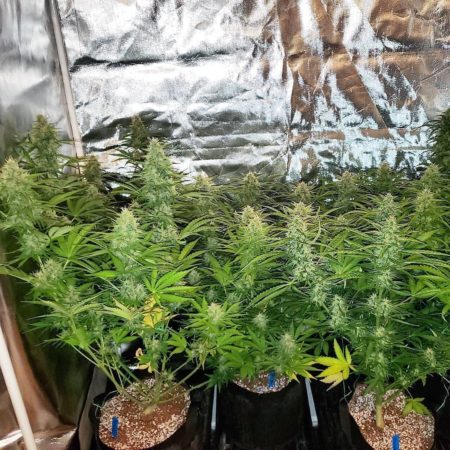
Main sign to watch out for: lower leaves are turning yellow, wilting, and falling off on their own (the leaves aren’t “stuck” on). If you see this, low nutrient levels are definitely a problem.
How to Fix: In hydroponics or coco, this is a matter of giving more nutrients in the water. If growing in soil, you have a few options depending on your setup.
Soil options:
- start giving extra soil nutrients in the water (easiest and quickest solution)
- top-dress with natural amendments (example 1-2 tsp/week per plant of Super Soil concentrate)
- top-dress with dry amendments (for example Earth Dust)
- give “teas” (worm tea, compost tea, Heisenburg tea, etc.)
- replant into fresh soil (though this should only be done at the beginning or right before the flowering stage to avoid stunting the plant)
Coco and Hydro:
If growing in coco or hydro, the simple fix is to increase the amount of base nutrients you’re using. You can increase the amount you’re adding to the water with fractions (for example if you’ve been giving 1/2 tsp per gallon you could start giving 3/4 tsp per gallon). If you want to avoid fractions, an easier option is to measure out the same nutrients as before, but use 10-20% less water. This keeps the exact same ratio, but at a higher nutrient strength. Whenever changing nutrient levels, make sure to check the pH of the water before giving it to plants. A PPM meter can be helpful because it lets you measure the overall “strength” of your nutrient water. This makes it easy to know whether you’re giving more or less overall. There is no exact right PPM for cannabis plants because each water source, nutrient system, and individual plant is different, but PPM meters let you adjust the nutrient strength more precisely.
2.) Environment
Your environment in the flowering stage is much more important than in the vegetative stage. Environment does not just affect plant health and leaves, it has a huge effect on your final bud quality/density/smell/yields. It’s important to give great plant care and start with good genetics, but you will never be able to grow outstanding weed if you don’t dial in the environment.
Heat – above 85°F (30°C)
- Leaves and/or buds may get discolored or crispy over time
- Symptoms are worse close to the lights where it’s most hot
Heat can sometimes cause problems that look like nutrient deficiencies
Buds that experience too much heat for too long can become crispy and discolored
How to fix heat:
- Vent out hot air from the grow space
- Increase air circulation
- Reduce the light power if possible
- Consider smaller/different grow lights that put out less heat (better to give plants less light at the right temperature than more light with tons of heat)
- Use an AC or evaporative cooler if the room itself is too hot
- Switch the timer so grow lights are off during the day when it’s hottest
- It can’t hurt to get a heat-resistant strain
Full tutorial on how to manage temperature in the grow room.
Cold – below 65°F (18°C)
- Slow growth
- Discolored or curled leaves
- Unexplained nutrient deficiencies
- Stems or leaves may turn red
- Plants tend to be droopy and may show symptoms similar to overwatering
- Buds don’t fatten up properly
- If it gets very cold, plants can get stunted or even die
- Cannabis grown under LEDs tends to be more sensitive to cold than under grow lights that use bulbs (pretty much all other grow lights including CFLs, T5, LEC/CMH, MH, HPS, etc).
This plant showed discoloration and curled tips after experiencing cold nights
After a night of freezing temperatures, some of the leaves on this plant turned almost white
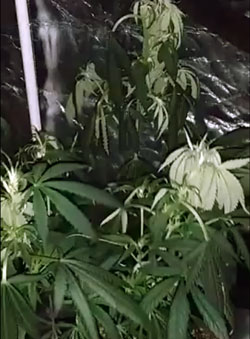
How to fix cold:
- Add insulation around grow space/tent
- Use a heater to raise the temperature of the room
- Switch the electrical timer so grow lights are on at night when it’s most cold
- Keep roots off the cold floor, especially in a cellar or garage. Plants can handle cooler temperatures if their roots stay warm. You can raise plants off the floor or put a seedling heat mat under the plants.
- Auto-flowering strains can be a good choice in winter because grow lights can be running up to 24 hours a day, preventing a cold dark period.
- Get a cold-resistant photoperiod strain like Northern Light x Skunk, Purple Queen, K.O. Kush, or Northern Light. Avoid haze or sativa-leaning strains.
Here’s a tutorial on how to manage temperature in the grow room. Here are some additional cold climate and winter tips for indoor growers.
Extreme Humidity
Optimal humidity is between 40-60% RH in the flowering stage. Outside that range can start causing plant problems.
- High humidity causes loose airy buds, slow plant growth, and bud rot
- Low humidity causes slow growth, nutrient deficiencies, and small buds
Bud rot is often the result of high humidity in the late flowering stage
Low humidity can cause slow growth and odd symptoms that may resemble over/under-watering or nutrient problems
How to fix humidity:
- Proper ventilation
- Use a humidifier or dehumidifier
- Get detailed instructions with many more tips on how to fix humidity
Grow Light Too Close
- Bleaching of buds or leaves
- Burnt spots and brown markings
- Crispy leaves
- Yellow tips on leaves closest to the light
Light stress may cause yellow tips on leaves closest to the light
A closeup of yellow tips on leaves from light stress
Leaves may feel crispy and leaf edges may start tipping up
Too-close grow lights can cause burning, especially when combined with heat
Bleaching is another common symptom of too-close lights (symptoms appear worse directly under grow light)
The buds themselves can even get bleached from light stress
How to fix too-close lights:
- Move lights further away
- Some grow lights have the option to reduce the power
- Switch to a less powerful grow light
- Learn more about too-close grow lights
Bad LEDs
Some LEDs seem to work just fine in the vegetative stage, but suddenly cause problems in the flowering stage. This used to be more common with older technology but can still happen with cheap generic LEDs. If you’re using a cheap LED grow light and plants seem to always start getting sick in the flowering stage, consider upgrading to a better grow light.
Some poor-quality LEDs work okay in the vegetative stage but cause problems in the flowering stage.
How to fix:
- If you’re going to use LEDs, get good ones! Your plants deserve it.
- Learn more about different LED grow lights for growing cannabis.
Recommended flowering LED lights (brands that work well with cannabis plants)
- Spider Farmer (Best Budget Light)
- Electric Sky (Best Yields)
- HLG Quantum Board (Best All-Around)
- Mars Hydro (Best Coverage)
- Custom LED Mix (Most Modular)
The Electric Sky 300 produced over 11 oz of buds from 3 plants. Check out the grow journal. This is probably my current favorite grow light for bigger grows (the HLG 65 is my favorite for mini grows).
Closeup of buds grown under HLG LEDs
The smaller HLG lights like the HLG 100 also produce excellent yields and bud quality in small spaces
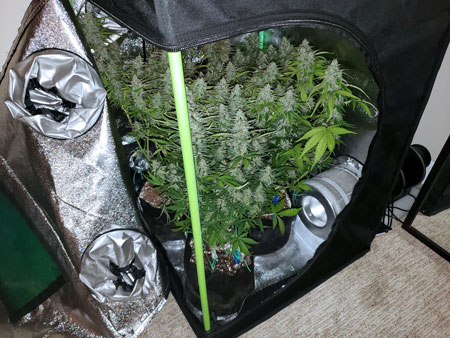
Bonus Cheat Sheet: Environmental factors that affect bud quality
Temperature When Lights are On
- High (above 85°F / 30°C) – tend to produce discoloration, poor plant growth, and low bud quality
- Medium-high (78-85°F / 25-30°C) – tend to get the best yields but middling bud quality (buds may be airier or have a lower smell)
- Medium-low (68-77°F / 20-25°C) – tend to produce lower yields but the best bud quality (prettier appearance, more colorful buds, greater bud density, and stronger smells) <– Recommended
- Low (under 68°F / 20°C) – causes plants to grow slow with low yields and buds that don’t develop fully.
Avoid high temperatures for the best bud quality after harvest
Temperature During Dark Period
- Temperature should ideally be a few degrees cooler during the dark period
- Stay above 65°F / 18°C even at night to prevent nutrient deficiencies, poor bud development, and slow growth
- Warm dark periods cause stem stretching and loose buds with air gaps inside the nugs
- Cool dark periods help bring out colors like pink or purple
Giver slightly cool periods to increase bud density and bring out colors
Humidity
- High humidity (above 60% RH) contributes to looser buds and an increased chance of mold or bud rot
- Mid-to-low humidity (40-60%) contributes to tighter buds with great trichome production
- Low humidity (under 40%) can cause plants to get stressed, lowering the overall yields
Keep humidity around 50% for dense, sparkly buds
Light distance
- Keep lights as close as possible to maximize yields and density
- Keep lights a bit further away to increase bud quality/smell/overall appearance (though yields are reduced)
If you don’t mind slightly smaller yields, keep lights a bit further away to improve the appearance and smell of buds
Light Type
- Fluorescent lights like CFLs and T5s produce excellent bud effects and smell, though lower bud density and yields per watt compared to other grow lights
- High-UV lights tend to increase trichome and smell production (for example CMH/LEC grow lights with a 4200k bulb produce extremely smelly, sparkly buds) at the expense of yields
- Wide-spectrum light that contains a lot of red (such as HPS, CMH/LEC with a 3100k bulb, and powerful red-spectrum LED grow lights like the HLG 300 R-Spec or Electric Sky 300s) tend to produce the densest buds, highest cannabinoids, and best yields per watt
The type of grow light affects how buds develop!
Genetics
Your bud quality is limited by strain. No matter what you do as a grower, you can’t overcome genetics. If a plant makes buds with 15% THC, there’s literally nothing you could do to get it to produce 25% THC. If a plant doesn’t produce a lot of trichomes, your buds won’t get sparkly regardless of grow tactics. If a strain is low-yielding, the yields will never be great. It’s important to start with the right genetics to get buds exactly the way you want.
- Don’t skimp on buying seeds. Get genetics that make you feel excited. If you’re going to invest in grow equipment and spend 3-5 months growing weed, you deserve great buds at the end. If you start with poor genetics, you’ll get subpar buds even if you do everything perfectly. On the other hand, if you start with a great strain, you’ll harvest good buds even if you make a lot of mistakes.
- Always do a little research to find the perfect strain to grow
- Get seeds from a trustworthy source
- Opt for American strains if you want sparkly buds (American genetics tend to have higher trichome production)
- However, I recommend you choose strains for the effects. Looks aren’t everything. Some of my favorite buds to smoke weren’t necessarily the prettiest!
Now you know how to grow happy plants with fat, beautiful buds!

